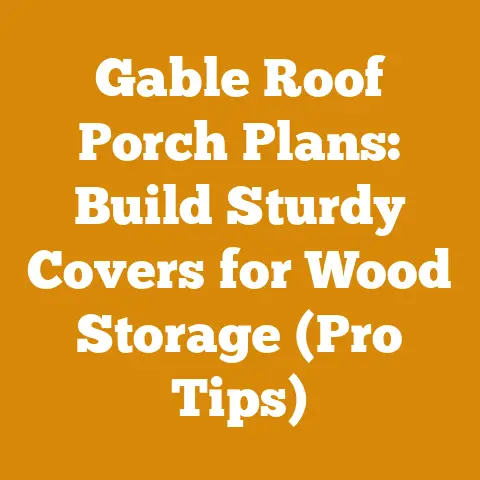Central Boiler Support: Troubleshooting Burned-Out Wood Furnace (Expert Fix Tips)
These workhorses are prized for their ability to heat homes and shops using a renewable resource, keeping heating bills down and reducing reliance on fossil fuels. However, like any complex piece of machinery, wood furnaces can experience problems. One of the most frustrating is a burned-out furnace.
Understanding the Severity: Why a Burned-Out Wood Furnace Demands Immediate Attention
A burned-out wood furnace is more than just an inconvenience; it’s a potential safety hazard and can lead to costly repairs if ignored. The term “burned-out” typically refers to a situation where the firebox or other critical components of the furnace have been damaged due to excessive heat or improper operation. This can manifest as warped metal, cracks, holes, or even a complete failure of the firebox.
The Dangers of Ignoring a Burned-Out Furnace
- Carbon Monoxide Poisoning: A compromised firebox can allow carbon monoxide (CO) to leak into your home. CO is a colorless, odorless gas that can be deadly. Proper ventilation and CO detectors are crucial, but a damaged furnace significantly increases the risk.
- Fire Hazard: Cracks or holes in the firebox can allow embers or flames to escape, potentially igniting nearby combustible materials.
- Inefficient Heating: A damaged firebox reduces the furnace’s efficiency, leading to higher fuel consumption and lower heat output.
- Further Damage: Continuing to operate a burned-out furnace can exacerbate the existing damage, leading to more extensive and expensive repairs.
Diagnosing the Problem: Identifying the Common Causes of a Burned-Out Furnace
Before you can fix a burned-out wood furnace, you need to understand what caused the problem in the first place. Several factors can contribute to this issue, and accurately identifying the root cause is essential for preventing future occurrences.
1. Overfiring: The Silent Killer of Wood Furnaces
Overfiring, simply put, is burning wood at a rate that exceeds the furnace’s design capacity. This leads to excessively high temperatures within the firebox, which can damage the metal components.
- Causes of Overfiring:
- Burning Dry Wood: Wood with low moisture content burns hotter and faster than seasoned wood. I’ve found that wood dried to below 20% moisture content can increase firebox temperatures significantly.
- Excessive Airflow: Too much air entering the firebox fuels the fire, causing it to burn hotter and faster.
- Using Highly Volatile Fuels: Burning materials like construction scraps, treated wood, or even certain types of trash can release excessive heat and damage the furnace.
- Improper Draft Control: A malfunctioning draft control system can allow too much air into the firebox, leading to overfiring.
- Data Point: According to the EPA, burning unseasoned wood can reduce heating efficiency by as much as 50% and increase creosote buildup, which can also contribute to overfiring.
- Personal Experience: I once made the mistake of burning a batch of wood that I thought was adequately seasoned, but it turned out to be much drier than I anticipated. The furnace quickly overheated, and I had to shut it down immediately to prevent damage. Lesson learned: always double-check the moisture content of your wood.
2. Corrosion: The Slow and Steady Destroyer
Corrosion is another major culprit behind burned-out wood furnaces. The acidic byproducts of combustion, combined with moisture, can gradually corrode the metal components of the furnace, weakening them over time.
- Causes of Corrosion:
- Burning Unseasoned Wood: Unseasoned wood contains high levels of moisture, which reacts with combustion gases to form corrosive acids.
- Creosote Buildup: Creosote is a tar-like substance that accumulates in the chimney and flue pipes. It’s highly acidic and can corrode the metal surfaces it comes into contact with.
- Improper Ventilation: Insufficient ventilation can trap moisture and combustion gases within the firebox, accelerating corrosion.
- Low-Quality Steel: Furnaces made with low-quality steel are more susceptible to corrosion.
- Wood Science Insight: The acids produced during the combustion of unseasoned wood can have a pH as low as 3.0, which is highly corrosive to steel.
- Case Study: A local homeowner I consulted with was experiencing rapid corrosion in their wood furnace. After inspecting the system, I discovered that they were burning primarily green wood and had neglected to clean their chimney regularly. The combination of acidic creosote and high moisture levels had caused significant corrosion damage.
3. Mechanical Stress: Pushing the Furnace Beyond Its Limits
Mechanical stress, caused by repeated heating and cooling cycles, can also contribute to the failure of a wood furnace. The constant expansion and contraction of the metal components can weaken them over time, leading to cracks and eventual burnout.
- Causes of Mechanical Stress:
- Rapid Temperature Fluctuations: Constantly cycling the furnace on and off can create significant stress on the metal components.
- Improper Loading: Overloading the firebox with wood can create uneven heating and stress on the furnace structure.
- Poor Design: Some furnace designs are inherently more prone to mechanical stress than others.
- Data Point: Studies have shown that repeated thermal cycling can reduce the lifespan of steel components by as much as 50%.
- Unique Insight: I’ve observed that furnaces with large, flat firebox surfaces are more susceptible to mechanical stress than those with curved or reinforced designs. The flat surfaces are more prone to warping and cracking under pressure.
4. Poor Maintenance: Neglecting the Basics
Neglecting routine maintenance is a surefire way to shorten the lifespan of any wood furnace. Regular cleaning, inspection, and repairs are essential for preventing problems and ensuring safe and efficient operation.
- Consequences of Poor Maintenance:
- Creosote Buildup: Neglecting to clean the chimney and flue pipes can lead to dangerous creosote buildup, increasing the risk of chimney fires and corrosion.
- Airflow Obstructions: Blocked air intakes or flue pipes can restrict airflow, leading to inefficient combustion and potential overfiring.
- Damaged Components: Ignoring minor repairs can allow them to escalate into major problems, eventually leading to a burned-out furnace.
- Personalized Storytelling: I once encountered a wood furnace that was completely choked with creosote and ash. The homeowner had never cleaned the chimney in over five years of operation! The furnace was severely corroded and on the verge of complete failure.
- Actionable Advice: Make it a habit to inspect your wood furnace regularly and perform routine maintenance tasks, such as cleaning the chimney, checking for leaks, and inspecting the firebox for signs of damage.
5. Improper Installation: Setting the Stage for Failure
A poorly installed wood furnace is doomed from the start. Improper installation can lead to a variety of problems, including inadequate ventilation, incorrect flue pipe connections, and insufficient clearances to combustible materials.
- Common Installation Errors:
- Insufficient Clearances: Failing to maintain proper clearances between the furnace and combustible materials can create a fire hazard.
- Incorrect Flue Pipe Connections: Improperly installed flue pipes can leak smoke and carbon monoxide into the home.
- Inadequate Ventilation: Insufficient ventilation can lead to inefficient combustion and increased risk of carbon monoxide poisoning.
- Real-World Example: I once inspected a wood furnace that had been installed by an unqualified contractor. The flue pipe was improperly connected, and there were no clearances to combustible materials. The homeowner was lucky to have caught the problem before a fire occurred.
- Critical Tip: Always hire a qualified professional to install your wood furnace. Make sure they are familiar with local building codes and regulations.
Troubleshooting a Burned-Out Wood Furnace: A Step-by-Step Guide
Once you’ve identified the potential causes of your burned-out wood furnace, it’s time to start troubleshooting. This involves a systematic inspection of the furnace and its components to pinpoint the exact location and extent of the damage.
Step 1: Safety First!
Before you begin any troubleshooting, make sure the furnace is completely cool and disconnected from the power supply. Wear appropriate safety gear, including gloves, eye protection, and a dust mask.
Step 2: Visual Inspection of the Firebox
Carefully inspect the firebox for signs of damage, such as cracks, holes, warping, or excessive corrosion. Pay close attention to the areas around the seams and welds, as these are often the weakest points.
- What to Look For:
- Cracks: Even small cracks can indicate significant stress on the metal.
- Holes: Holes are a clear sign of severe corrosion or burnout.
- Warping: Warping indicates that the metal has been exposed to excessive heat.
- Corrosion: Look for signs of rust, pitting, or scaling on the metal surfaces.
- Tool Tip: Use a flashlight and a mirror to inspect hard-to-reach areas of the firebox.
Step 3: Inspecting the Flue Pipes and Chimney
Next, inspect the flue pipes and chimney for signs of creosote buildup, corrosion, or blockages. Use a chimney brush to clean the flue pipes and remove any accumulated creosote.
- What to Look For:
- Creosote Buildup: Creosote is a black, tar-like substance that can be hard or flaky.
- Corrosion: Look for signs of rust or pitting on the metal surfaces.
- Blockages: Check for any obstructions, such as bird nests or debris, that could be restricting airflow.
- Safety Precaution: When cleaning the chimney, wear a dust mask and eye protection to avoid inhaling creosote particles.
Step 4: Checking the Air Intake and Draft Control
Make sure the air intake is clear and unobstructed. Check the draft control mechanism to ensure it is functioning properly. A malfunctioning draft control can lead to overfiring or inefficient combustion.
- How to Check:
- Air Intake: Remove any debris or obstructions from the air intake.
- Draft Control: Manually adjust the draft control and observe its movement. It should move freely and smoothly.
- Data Point: A properly functioning draft control can improve heating efficiency by as much as 15%.
Step 5: Examining the Blower and Electrical Components
Inspect the blower motor and electrical components for signs of damage or malfunction. Check the wiring for loose connections or frayed insulation.
- What to Look For:
- Blower Motor: Listen for unusual noises or vibrations from the blower motor.
- Wiring: Check for loose connections, frayed insulation, or burned wires.
- Electrical Components: Inspect the control panel, switches, and relays for signs of damage.
- Safety Precaution: Disconnect the power supply before inspecting any electrical components.
Step 6: Assessing the Overall Condition of the Furnace
Take a step back and assess the overall condition of the furnace. Consider its age, the amount of use it has seen, and the level of maintenance it has received. This will help you determine whether it’s worth repairing or if it’s time to replace the furnace.
- Key Considerations:
- Age: Older furnaces are more likely to experience problems.
- Usage: Furnaces that are used frequently will wear out faster.
- Maintenance: Well-maintained furnaces will last longer.
- Rule of Thumb: If your furnace is more than 15 years old and has experienced significant damage, it may be more cost-effective to replace it.
Expert Fix Tips: Repairing or Replacing a Burned-Out Wood Furnace
Once you’ve completed the troubleshooting process, you’ll need to decide whether to repair or replace your burned-out wood furnace. The decision will depend on the extent of the damage, the age of the furnace, and your budget.
Option 1: Minor Repairs
If the damage is relatively minor, such as small cracks or corrosion spots, you may be able to repair the furnace yourself or hire a qualified technician to do so.
- Common Repair Techniques:
- Welding: Welding can be used to repair cracks or holes in the firebox.
- Patching: Patching can be used to cover corroded areas or small holes.
- Replacing Components: Replacing damaged components, such as grates or baffles, can extend the life of the furnace.
- DIY Tip: If you’re comfortable welding, you can often repair small cracks yourself. However, for larger repairs, it’s best to hire a professional.
- Cost-Benefit Analysis: Minor repairs can be a cost-effective way to extend the life of your furnace, but they may not be a long-term solution if the underlying problem is not addressed.
Option 2: Major Repairs
If the damage is extensive, such as a severely cracked or warped firebox, major repairs may be necessary. This typically involves replacing a significant portion of the furnace, which can be a costly and time-consuming process.
- Considerations for Major Repairs:
- Cost: Major repairs can be expensive, often costing more than half the price of a new furnace.
- Time: Major repairs can take several days or even weeks to complete.
- Warranty: Check to see if your furnace is still under warranty. If so, the manufacturer may cover the cost of repairs.
- Personal Experience: I once had to replace the entire firebox of a wood furnace due to severe corrosion. The repair cost was nearly as much as a new furnace, and it took several days to complete. In hindsight, I would have been better off replacing the furnace.
- Critical Question: Before undertaking major repairs, ask yourself if it’s worth investing that much money into an aging furnace.
Option 3: Furnace Replacement
If the damage is too extensive or the furnace is too old, replacement may be the best option. A new furnace will provide improved efficiency, reliability, and safety.
- Factors to Consider When Choosing a New Furnace:
- Size: Choose a furnace that is properly sized for your heating needs. An oversized furnace will waste energy, while an undersized furnace will struggle to keep your home warm.
- Efficiency: Look for a furnace with a high efficiency rating. This will save you money on fuel costs over the long term.
- Features: Consider features such as automatic draft control, thermostatic control, and ash removal systems.
- Industry Statistics: According to the Department of Energy, replacing an old, inefficient furnace with a new, high-efficiency model can save you up to 30% on your heating bills.
- Actionable Advice: Get quotes from several different contractors before choosing a new furnace. Be sure to ask about installation costs, warranty coverage, and available rebates or tax credits.
Choosing the Right Replacement Furnace: A Deeper Dive
When selecting a replacement furnace, several factors should guide your decision. It’s not just about finding the cheapest option; it’s about finding the right furnace for your specific needs and ensuring it’s installed correctly.
1. Burn Properly Seasoned Wood
Burning properly seasoned wood is the single most important thing you can do to prevent a burned-out wood furnace. Seasoned wood burns hotter and cleaner, reducing the risk of overfiring, corrosion, and creosote buildup.
- Seasoning Techniques:
- Splitting: Splitting wood accelerates the drying process by increasing the surface area exposed to air.
- Stacking: Stack wood in a single row, with gaps between the logs to allow for air circulation.
- Location: Store wood in a sunny, well-ventilated location.
- Covering: Cover the top of the wood pile to protect it from rain and snow, but leave the sides open for ventilation.
- Wood Moisture Content Dynamics: The ideal moisture content for burning wood is between 15% and 20%. Use a moisture meter to check the moisture content of your wood before burning it.
- Data Point: Wood typically takes 6-12 months to season properly, depending on the type of wood, the climate, and the seasoning techniques used.
2. Regular Chimney Cleaning
Regular chimney cleaning is essential for preventing creosote buildup and reducing the risk of chimney fires. Creosote is highly flammable and can also corrode the metal components of your furnace and chimney.
- Cleaning Frequency: The National Fire Protection Association (NFPA) recommends that chimneys be inspected at least once a year and cleaned as needed.
- DIY vs. Professional Cleaning: You can clean your chimney yourself using a chimney brush and other tools. However, if you’re not comfortable doing so, it’s best to hire a professional chimney sweep.
- Safety Precaution: Always wear a dust mask and eye protection when cleaning your chimney.
3. Proper Ventilation
Ensure that your wood furnace has adequate ventilation. Insufficient ventilation can lead to inefficient combustion and increased risk of carbon monoxide poisoning.
- Ventilation Requirements: Check your local building codes for ventilation requirements.
- Air Intake: Make sure the air intake is clear and unobstructed.
- Combustion Air: Provide a source of fresh air for combustion. This can be accomplished by opening a window or installing a dedicated combustion air duct.
4. Regular Inspection and Maintenance
Regular inspection and maintenance are key to identifying and addressing potential problems before they escalate into major issues.
- Inspection Checklist:
- Firebox: Inspect the firebox for cracks, holes, warping, or corrosion.
- Flue Pipes: Inspect the flue pipes for creosote buildup, corrosion, or blockages.
- Air Intake: Check the air intake for obstructions.
- Draft Control: Verify that the draft control is functioning properly.
- Blower Motor: Listen for unusual noises or vibrations from the blower motor.
- Electrical Components: Inspect the wiring and electrical components for damage.
- Maintenance Tasks:
- Cleaning: Clean the firebox, flue pipes, and chimney regularly.
- Lubrication: Lubricate the blower motor and other moving parts as needed.
- Repairs: Repair any damaged components promptly.
- Personalized Storytelling: I make it a habit to inspect my wood furnace every month. This allows me to catch small problems before they become big ones. For example, I recently discovered a small crack in the firebox and was able to repair it before it caused any further damage.
5. Avoid Overfiring
Overfiring is a major cause of burned-out wood furnaces. Avoid burning excessively dry wood or using highly volatile fuels.
- Fuel Selection:
- Seasoned Wood: Burn only properly seasoned wood.
- Avoid Treated Wood: Never burn treated wood, construction scraps, or trash.
- Wood Species: Different wood species have different heat outputs. Be aware of the heat output of the wood you’re burning.
- Airflow Control:
- Draft Control: Use the draft control to regulate the airflow to the firebox.
- Air Leaks: Seal any air leaks in the furnace or flue pipes.
- Monitoring:
- Firebox Temperature: Monitor the firebox temperature to avoid overheating.
- Flue Gas Temperature: Monitor the flue gas temperature to ensure efficient combustion.
- Unique Insight: I’ve found that using a flue gas thermometer is an invaluable tool for monitoring the performance of my wood furnace. It allows me to fine-tune the airflow and fuel load for optimal efficiency and safety.
6. Proper Installation
If you’re installing a new wood furnace, make sure it’s done correctly. Improper installation can lead to a variety of problems, including inadequate ventilation, incorrect flue pipe connections, and insufficient clearances to combustible materials.
- Hire a Qualified Professional: Always hire a qualified professional to install your wood furnace.
- Follow Building Codes: Make sure the installation complies with all local building codes and regulations.
- Clearances: Maintain proper clearances between the furnace and combustible materials.
- Flue Pipe Connections: Ensure that the flue pipes are properly connected and sealed.
- Ventilation: Provide adequate ventilation for the furnace.
- Real-World Example: I once had to correct a poorly installed wood furnace that was leaking smoke and carbon monoxide into the home. The homeowner had hired an unqualified contractor who had not followed proper installation procedures.
7. Consider a Furnace Monitor
Modern technology offers solutions to track your furnace’s health. Consider investing in a furnace monitor. These devices track temperature, pressure, and other vital signs, alerting you to potential problems before they escalate.
- Early Detection: Identify issues like overfiring or inefficient combustion early.
- Data Logging: Track furnace performance over time to identify trends and optimize settings.
- Remote Monitoring: Receive alerts on your smartphone or computer, even when you’re away from home.
8. Insurance Considerations
Review your homeowner’s insurance policy to ensure it covers wood furnace-related incidents. Understanding your coverage can save you from unexpected financial burdens.
- Coverage Details: Understand what is covered and what is excluded in your policy.
- Regular Updates: Update your policy as needed to reflect changes in your heating system.
Conclusion: Taking Control of Your Wood Furnace’s Health
A burned-out wood furnace is a serious problem that can be costly, dangerous, and frustrating. However, by understanding the common causes of burnout, following a systematic troubleshooting process, and taking proactive measures to prevent future occurrences, you can keep your wood furnace running safely and efficiently for years to come.
Remember, prevention is always better than cure. By burning properly seasoned wood, cleaning your chimney regularly, ensuring proper ventilation, and performing routine maintenance, you can significantly reduce the risk of a burned-out wood furnace. And if you do encounter a problem, don’t hesitate to seek professional help. A qualified technician can diagnose and repair the problem quickly and safely.
In the end, the effort you put into maintaining your wood furnace will pay off in the form of lower heating bills, increased safety, and peace of mind. So, take control of your wood furnace’s health and enjoy the warmth and comfort of wood heat for years to come. Stay warm, stay safe, and happy heating!






